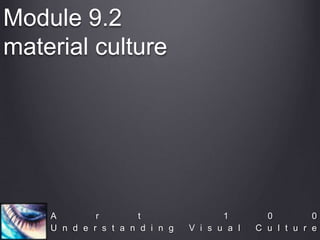
ART100Sp15Wk9Cl2
- 1. Module 9.2 material culture A r t 1 0 0 U n d e r s t a n d i n g V i s u a l C u l t u r e
- 14. what is material culture? Understanding human history through things that humans have made. Discipline of history—tends to use texts to reconstruct what happened. Discipline of art history—tends to use visual imagery to reconstruct what happened Interdiscipline of material culture—tends to use objects to reconstruct what happened. In this way, it is closest to the formal discipline of archaeology, except, it is not only excavating the distant past.
- 15. how broad is the definition? rather broad! material culture could include anything from: high-fashion clothing to the simplest t-shirt or sock one-of-kind objects made by craftspeople or designers to mass-produced toothbrushes or dogbowls or toasters technological and mechanical objects parts of buildings and architectural elements
- 17. Spiral Staircase, The Rookery Building, Burnham & Root, 1888
- 18. Why do we need material culture? Jules Prown, “Mind in Matter,” (1982), p. 1 “ALTHOUGH ART MUSEUMS, historical societies, museums of history and technology, historic houses, open-air museums, and museums of ethnography, science, and even natural history, have long collected, studied, and exhibited the material of what has come to be called material culture, no comprehensive academic philosophy or discipline for the investigation of material culture has as yet been developed.”
- 19. Olivetti, Lettera 22, 1950
- 20. Krannert Art Museum Addition, University of Illinois, Urbana- Champaign, 1985
- 21. The First Floor Education Director Anne Sautman leading a gallery discussion
- 22. The Basement Louis Sullivan, Elevator Gate from The Chicago Stock Exchange Building, 1894, Cast-iron with bronze plating
- 24. How do we define material culture? Jules Prown, “Mind in Matter,” (1982), p. 1 “Material culture is the study through artifacts of the beliefs —values, ideas, attitudes, and assumptions—of a particular community or society at a given time. The term material culture is also frequently used to refer to artifacts themselves, to the body of material available for such study. I shall restrict the term to mean the study and refer to the evidence simply as material or artifacts.”
- 25. What is an artifact? Ordinary old pebble Pebble tools, Olduvai Gorge, Tanzania, 1.8 million years ago
- 26. artifact a usually simple object (as a tool or ornament) that shows evidence of human modification or workmanship, as distinct from a naturally occurring thing
- 27. Piece of obsidian (volcanic glass)
- 28. Obsidian tools Properties of the material are enhanced by human intervention
- 29. Are these naturally-occurring things, or artifacts?
- 30. Why bother with objects? Wouldn’t words and deeds be more revealing of culture? Jules Prown “Mind in Matter” (1982) p. 3 Why should one bother to investigate material objects in the quest for culture, for a society's systems of belief? Surely people in all societies express and have expressed their beliefs more explicitly and openly in their words and deeds than in the things they have made. Are there aspects of mind to be discovered in objects that differ from, complement, supplement, or contradict what can be learned from more traditional literary and behavioral sources?
- 31. What could be culturally revealing about the study of objects? Objects survive and provide direct and tangible evidence of the past. This allows us to “experience” the past through empathetic engagement of our senses.
- 32. What doors might the study of objects open? Jules Prown, “Mind in Matter,” (1982), p. 5 "This affective mode of apprehension through the senses that allows us to put ourselves, figuratively speaking, inside the skins of individuals who commissioned, made, used, or enjoyed these objects, to see with their eyes and touch with their hands, to identify with them empathetically, is clearly a different way of engaging the past than abstractly through the written word. Instead of our minds making intellectual contact with minds of the past, our senses make affective contact with senses of past.” —Arnold Hauser, Sociology of Art
- 33. What could be culturally revealing about the study of objects? Objects might be more representative of what people in a society are doing, thinking and feeling than words are.
- 34. Jules Prown “Mind in Matter” (1982) p. 3 Henry Glassie has observed that only a small percentage of the world's population is and has been literate, and that the people who write literature or keep diaries are atypical. Objects are used by a much broader cross section of the population and are therefore potentially a more wide- ranging, more representative source of information than words.
- 35. What are the limitations of studying objects? “The theoretical democratic advantage of artifacts in general, and vernacular material in particular, is partially offset by the skewed nature of what in fact survives from an earlier culture. A primary factor in this is the destructive, or the preservative, effect of particular environments on particular materials. Materials from the deeper recesses of time are often buried, and recovered archaeologically. Of the material heritage of such cultures, glass and ceramics survive in relatively good condition, metal in poor to fair condition, wood in the form of voids (postholes), and clothing not at all (except for metallic threads, buttons, and an odd clasp or hook).”
- 37. Have a great break! See you in 2 weeks!
